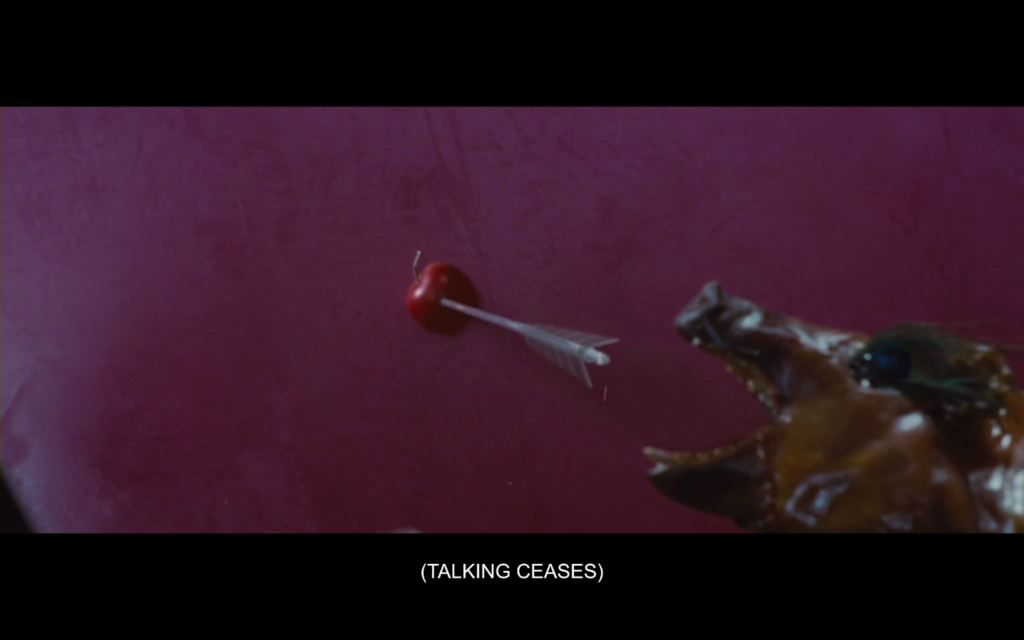Food and Resistance in The Hunger Games
BY Marielle BianchiThe film The Hunger Games, released in 2012 and directed by Gary Ross and Francis Lawrence, takes place in a dystopian society where the population is divided into twelve Districts and the wealthy Capitol. Districts One and District Two are provided with plenty of food, while lower Districts, such as District Eleven and District Twelve, are barely given enough resources to survive. Each year, two kids from each District are randomly chosen from a lottery to participate in the Hunger Games. The Hunger Games is a tradition where twenty-six kids are put into an arena, given weapons and supplies, and forced to battle to the death. The last person standing is the winner, and they receive endless wealth from the Capitol.
The film’s main character, Katniss, comes from District Twelve, the poorest District, and her family barely has enough money to buy food for survival. After her sister is chosen for the Hunger Games, Katniss volunteers to go in her place. A boy named Peeta is selected from her District as well. Throughout the film, food is used in reference to the power in the Capitol, and to show a stark contrast between Katniss and the Capitol. Katniss is forced to hunt illegally, and other characters consume alcohol as an escape. Food calls attention to the corruption of the Capitol and the citizens’ attempts to resist the restricting laws of the dictatorship.
The Capitol outlaws hunting, which is one of the only ways to obtain food outside of the District grounds. In order to have more control over the citizens, the Capitol does not provide District Twelve with enough food or supplies for them to survive, which leads to Katniss leaving her District to hunt illegally (fig. 1). When Katniss’s friend buys a loaf of bread, Katniss treats it like a delicacy because she has so little food. Another option citizens have to get more food is to voluntarily put their name into the lottery for the Hunger Games multiple times. This is an option called tesserae, whereby a child puts their name in the lottery additional times so that the government supplies their family with more food. Caroline Jones states in her article “Changing the World: Faces of Rebellion in Suzanne Collins’s Hunger Games Trilogy,” The need for tesserae highlights the extreme wealth gap between the Districts, particularly District Twelve, and the Capitol, and it also ensures the Capitol’s hegemonic position: they control the resources within the Districts, and by exchanging food rations for names, they remind the poorest of the poor that the odds are never in their favor (Jones 227).
The Capitol designs the laws of the society to actively harm its citizens in order for the dictatorship to remain in power. Rather than giving the people enough food to survive, the Capitol deprives them of basic necessities for survival to force them to rely on the Capitol. This extreme lack of food compared to the extreme wealth of the Capitol shows the corruption of the wealthy. By hunting illegally, Katniss shows her defiance of the Capitol and her resistance against their unjust and restrictive laws by breaking the rules.
Whoever wins the Games is promised extreme riches and wealth; however, many victors face a harsh reality after the Games are over. The Capitol forces the victors of the games to mentor the new tributes each year, which once again shows the Capitol’s corruption as they are causing the victors to relive their traumatic experiences in the Games. Katniss’s mentor, Haymitch, is always drunk, which makes it difficult for him to give Katniss and Peeta advice on how to survive (fig. 2). Haymitch came from District Twelve, which means that he too grew up with very little food. After winning the Games, he has grown so used to forced starvation that he abuses his wealth and drinks an excess of alcohol to numb the wounds that the Capitol caused. Adam Routinghaus describes a reality similar to the film in his article “The End of Material Scarcity: Dystopia and Immanent Critique of Capitalism”:
The advertising in the late nineteenth and early twentieth centuries often depicted ”fables of abundance” that used agrarian images of plenty to depict industrial capitalism’s promise to deliver an untold bounty of goods. Post-industrial capitalism, like industrial capitalism before it, has continually failed to fulfill this promise. (348)
Similar to the advertising in industrial capitalism, the Capitol advertises the victors a life of extravagance and happiness. They promise a perfect life after the Games filled with fame and riches, but the victors are traumatized and unable to escape the grasp of the Capitol after the Games are over. Haymitch’s usage of alcohol symbolizes his flawed effort to numb his trauma, resist the Capitol’s attempt to force him to relive his time in the Games, and escape the constant reminder of the Capitol’s power.

Corruption among the wealthy is prevalent in the extravagant meals the judges indulge in while the tributes from each District show off their skills. Each tribute presents their skills to the judges, and then the judges give each of them a score, which shows both the public and the other tributes who will be most and least dangerous. This score means life or death for some of the tributes. However, when Katniss is called to perform her skill, the judges are not paying attention and instead feast on large amounts of food. Katniss becomes angry and decides to show her talent by shooting an arrow through an apple in the pig’s mouth (fig. 3).
Brianna Burke discusses the stark difference between how the Capitol treats the citizens in the lower Districts and the citizens in the higher Districts in her article “‘Reaping’ Environmental Justice through Compassion in The Hunger Games” when she states, “The subjugation of the poor through the consumptive desires of the wealthy is unjust; and … we must turn away from a system based solely on economic gain and exploitative greed” (546). The wealthy society uses the citizens of the poorer Districts as a product for their entertainment, and as soon as they are no longer interesting, they are disregarded. This is shown explicitly in this scene with the apple in the pig’s mouth. While the wealthy judges are feasting on more food than many of the tributes have ever seen, the tributes are trying their best to do whatever they can to survive. Katniss’ food-related act of defiance shows her resistance and unwillingness to accept the corruption of the Capitol and her attempt to take a stand against the wealthy.

The corruption in the Capitol is evident when they change the rules to manipulate the tributes. In the middle of the Games, the Game Master announces that there may be two victors, but only if they come from the same District. However, after Katniss and Peeta are the last ones alive, the Game Master reverses the rule to force them to try and kill each other. Katniss refuses and tells Peeta that they will eat poisonous berries to take a stand against the Capitol (fig. 4). In her article, Burke states, “The children dying in the Games are literally consuming entertainment” (546). The mid-game rule change was proven to only be for entertainment purposes, given that the Capitol was not genuinely planning to allow both of the remaining tributes to live. The only reason they care that Peeta and Katniss are going to die is that they would not have a victor, not because of any concern for the contestants’ lives. Katniss and Peeta would rather sacrifice their lives than let the corruption of the Capitol win, and by threatening to eat the berries, they make the Capitol surrender, which has never happened before. The incident with the berries represents Katniss and Peeta’s unwillingness to comply with the Capitol’s deception and corruption, and their resistance against the unjust rules.
Throughout The Hunger Games, incidents with food act as a symbol of defiance against the corruption of the Capitol. The Capitol is so powerful that it is almost impossible to defy their rules. However, the characters use food in small ways that represent their attempts to escape the control of the Capitol. Illegal hunting is a way to get around the restricting laws created by the Capitol. Haymitch’s alcohol consumption is one of the only ways he can escape his past. Katniss shooting an arrow at an apple—a simple act of defiance—leads to the more significant gesture of choosing to eat the poisonous berries, a final act of resistance that the Capitol is unable to ignore.
Works Cited
Burke, Brianna. “‘Reaping’ Environmental Justice through Compassion in The Hunger Games.” Interdisciplinary Studies in Literature and Environment 22.3 (2015): 544-67.
Jones, Caroline E. “Changing the World: Faces of Rebellion in Suzanne Collins’s Hunger Games Trilogy.” Journal of the Fantastic in the Arts 27.2 (2016): 225-47.
The Hunger Games. Dir. Gary Ross and Francis Lawrence. Lions Gate Entertainment, 2012.
Rottinghaus, Adam Richard, et al. “The End of Material Scarcity: Dystopia and Immanent Critique of Capitalism.” ETC: A Review of General Semantics 72.4 (2015): 347-58.
About the Author
Marielle Bianchi is a first-year student at Fordham College at Rose Hill majoring in Psychology. She is originally from New Milford, Connecticut, and her hobbies include watching movies, reading books, and discovering new restaurants in the city. Her love of movies and food inspired this essay, which explores the role food plays in The Hunger Games.


